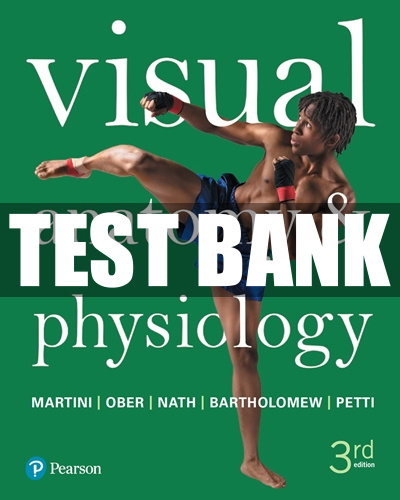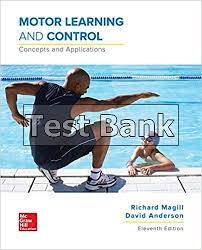Visual Anatomy & Physiology 3E By Martini – Test Bank
Original price was: $55.00.$19.50Current price is: $19.50.
Digital item No Waiting Time Instant Download
ISBN: 9780134394695 | 9780134454658
0134454650 | 9780134511191 | 0134511190
Edition :3rd Edition
Author :Martini
Copyright: 2018
Publisher: Pearson
Description
Visual Anatomy & Physiology 3E By Martini – Test Bank
Table of Contents
Visual Anatomy and Physiology, 3e (Martini)
Chapter 1 An Introduction to Anatomy and Physiology
Multiple Choice Questions
1) The maintenance of a constant internal environment in an organism is termed
A) positive feedback.
B) homeostasis.
C) negative feedback.
D) effector control.
E) integration.
Answer: B
Learning Outcome: 1.6
Bloom’s Taxonomy: Remembering
2) Gas exchange is to the respiratory system as absorption of nutrients is to the ________ system(s).
A) lymphatic
B) urinary
C) digestive
D) cardiovascular
E) urinary and cardiovascular
Answer: C
Learning Outcome: 1.7
Bloom’s Taxonomy: Understanding
3) Which organ system removes carbon dioxide from the bloodstream?
A) cardiovascular
B) lymphatic
C) respiratory
D) digestive
E) endocrine
Answer: C
Learning Outcome: 1.7
Bloom’s Taxonomy: Remembering
4) Anatomy is to ________ as physiology is to ________.
A) function; form
B) form; structure
C) structure; function
D) structure; form
E) growth; form
Answer: C
Learning Outcome: 1.8
Bloom’s Taxonomy: Understanding
5) The central principle of physiology is
A) nutrition.
B) reflexes.
C) homeostasis.
D) stimulation.
E) temperature regulation.
Answer: C
Learning Outcome: 1.8
Bloom’s Taxonomy: Remembering
6) Because the anatomy and physiology of the body’s structures are interrelated, it is often said that “form determines ________.”
A) anatomy
B) physiology
C) structure
D) function
E) biology
Answer: D
Learning Outcome: 1.9
Bloom’s Taxonomy: Remembering
7) A chemical imbalance in the blood can cause the heart to stop pumping blood, which in turn will cause other tissues and organs to cease functioning. This observation supports the view that
A) all organisms are composed of cells.
B) all levels of organization within an organism are interdependent.
C) chemical molecules make up cells.
D) blood has magical properties.
E) congenital defects can be life-threatening.
Answer: B
Learning Outcome: 1.10
Bloom’s Taxonomy: Understanding
8) Which of the following is arranged in correct order from the most complex to the simplest?
A) cellular, tissue, molecular, system, organ, organism
B) molecular, cellular, tissue, organ, system, organism
C) tissue, cellular, molecular, organ, system, organism
D) organ, organism, molecular, cellular, tissue, system
E) organism, system, organ, tissue, cellular, molecular
Answer: E
Learning Outcome: 1.10
Bloom’s Taxonomy: Remembering
9) What is the smallest living level of organization?
A) cellular level
B) chemical level
C) organ level
D) organ system level
E) tissue level
Answer: A
Learning Outcome: 1.11
Bloom’s Taxonomy: Remembering
10) Which of the following cell types is long, slender and makes contractions?
A) red blood cells
B) bone cells
C) fat cells
D) muscle cells
E) white blood cells
Answer: D
Learning Outcome: 1.11
Bloom’s Taxonomy: Remembering





Be the first to review “Visual Anatomy & Physiology 3E By Martini – Test Bank”